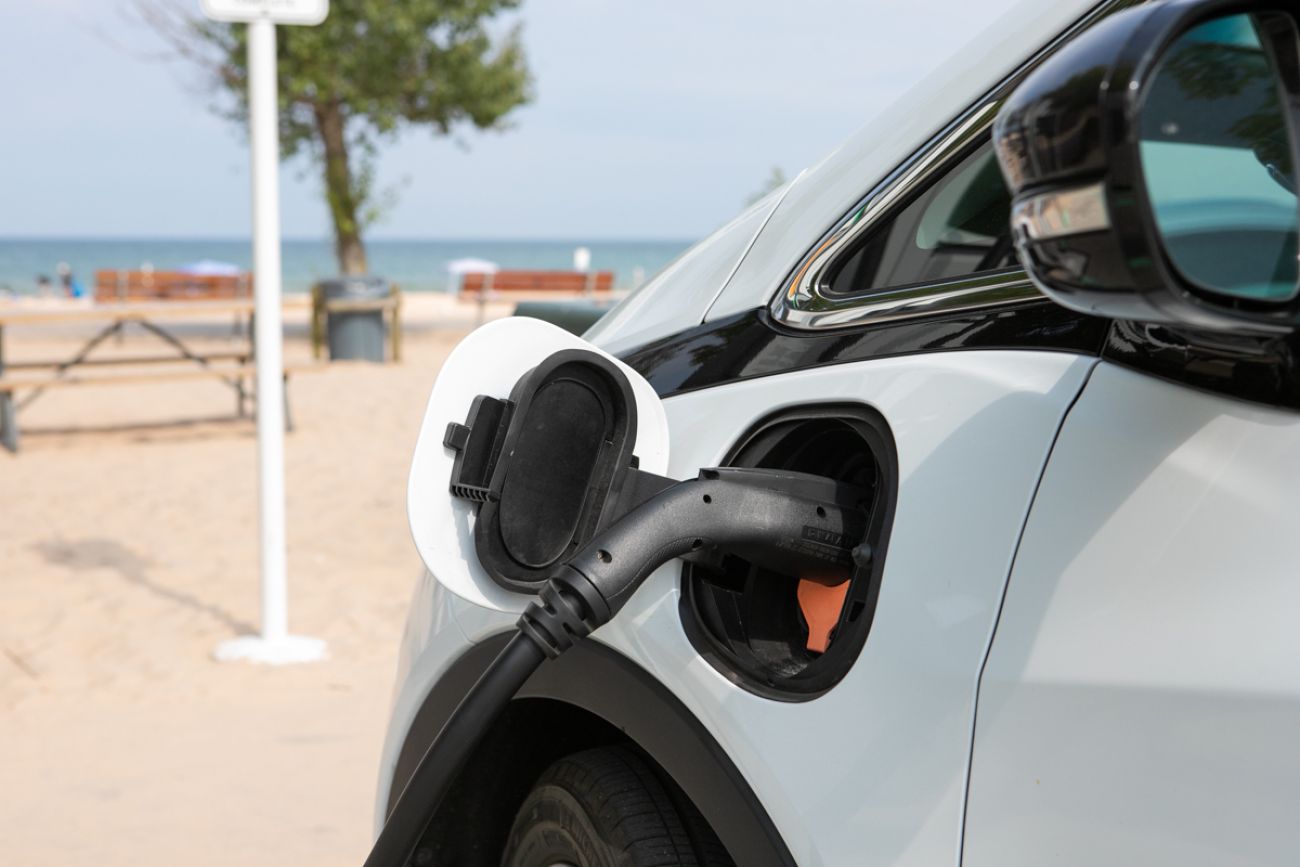Which Michigan counties have most EVs? Which have none? Politics play a role

- Michigan’s top EV-owning counties are mostly well-off, politically left-leaning places with lots of access to chargers.
- Rural northern Michiganders are least likely to own EVs.
- Closing the gap is crucial to the state’s plan to put 2 million people into EVs by 2030.
Washtenaw County has a reputation for environmentalism and liberalism.
It was the first Michigan county to attempt a plastic bag ban; the first with a climate action plan; and the county seat of Ann Arbor is banning gas-powered leaf blowers because of their carbon emissions. It last voted for a Republican for president in 1984.
So perhaps it's no surprise that the county is also Michigan’s de facto capital of electric vehicle ownership.
Residents there are nearly three times more likely to drive an EV than the average Michigander, with 4,380 registered electric vehicles among the county of 366,000 residents, according to data obtained by Bridge Michigan.
That’s almost 17 times as many as in the entire Upper Peninsula, which is home to 261 registered EVs, Secretary of State records show.
But politics and environmentalism explain only some of the differences.
With an average sticker price of $56,371, “EVs, at this point, are not an inclusive and obtainable technology to the masses,” said Glenn Stevens, executive director of MichAuto, which is affiliated with the Detroit Regional Chamber.
The median household income in Washtenaw County is $84,000, or about $17,000 above the state average.
Related:
- Watch Bridge’s Lunch Break on the impact of electric vehicles on Michigan
- EV transition a slow go in Michigan. It needs 100,000 chargers, has 3,300
- Michigan has spent $1B on EV, battery plants. So far, they’ve created 200 jobs
- Road trips are key to making EVs work in Michigan. They’re doable now. Barely
As politicians and automakers strive to entice millions of Michiganders into EVs within the next few years, Bridge scrutinized vehicle registration figures from the Michigan Secretary of State to find out how the transition is going so far.
The data reveals a sharp demographic divide between Michigan’s EV early adopters and those who are sticking with gas for now. And it underscores how vehicle cost, charging access and politics can make or break a person’s decision to buy an EV.
Here’s what we found:
Michigan is an EV adoption laggard
Only two Michigan counties topped 1% EV ownership: Washtenaw, with 1.74%, and Oakland, with 1.5%.
Oakland County by far has the most EVs: 15,871, but also far more residents than Washtenaw (1.2 million), while Wayne County has nearly 7,300 EVs among its 1.7 million residents.
Those figures underscore Michigan’s slowpoke adoption of EVs even while the state’s automakers rush to produce them.
Nationally, 1.3% of drivers own an EV and 9% of new-car buyers are choosing one. Michigan is below average on both metrics, with an EV ownership rate of 0.63% and a 3.2% share of the new car market.
Compare that to California, the nation’s EV adoption leader, where EVs make up nearly a quarter of all new vehicle purchases and 5% of cars on the road.
Policy and culture explain California’s embrace of EVs and Michigan’s slow uptake, Stevens said.
“It's the policy environment that California has set down to move to net zero carbon,” he said. “And you have a different consumer,” with little to no brand allegiance to Detroit-based automakers.
EV ownership correlates with wealth, politics and density
The state data shows EVs are more popular in more population-dense, left-leaning and better-off areas of the state.
Residents there are more likely to have the money to afford an EV, have easier access to in-home chargers and public charging, and support the climate policies that drive the EV transition.
“Lay a poverty heat map over (a map of EV ownership), and my guess is that the majority of EVs, certainly in the near term, are going to fill in the spaces where there's no red on the heat map for poverty,” Stevens said.
Indeed: After Washtenaw, the top EV-owning counties are Oakland, Leelanau, Kent, Ingham and Kalamazoo. All but one have median household incomes higher than the state average of $66,986.
In the Upper Peninsula, Marquette County is home to just 24,000 of the UP’s 311,000 residents, but nearly one-third of its EVs (61) and the highest median household income ($63,000.)
All seven of the EV-loving counties went for Joe Biden in the 2020 presidential election. That’s a reality that speaks to the “highly politicized” nature of EVs, Stevens said.
Former President Donald Trump has called EVs a “transition to hell,” while his opponent, Vice President Kamala Harris, promotes them as a solution for the economy and climate.
Compare early-adopting counties to Luce County in the Upper Peninsula, which is Michigan’s only county with no registered EVs. It’s deeply conservative, with a median household income of $51,000 and just one public charging station spread across its 899 square miles.
The average new EV costs more than double the average Luce County resident’s yearly income, and nearly $8,000 more than a new gas powered car.
Another possible factor: EVs have lower battery ranges in extreme cold weather, which is often the norm in the Upper Peninsula.
Of the five least EV-owning counties, all are in rural northern Michigan (four of them in the UP) with lower-than-average incomes. Luce is followed by Oscoda, Alger, Ontonagon, and Schoolcraft counties.
“For people who are budget constrained, like most of us, the actual price of that vehicle is very important,” said Cristina Benton, a senior consultant with Anderson Economic Group who has tracked Michigan’s EV transition.
Beyond income, access to public chargers plays a role in consumers’ decision to buy an EV.
And Michigan’s EV-hesitant Upper Peninsula as ground zero for “range anxiety” in Michigan, with few public chargers and vast forests where there are few viable places to install more.
“Some stretches of road, there is nothing there,” said Mehrnaz Ghamami, a Michigan State University researcher who studies the state’s charging needs. “It would be a charger in the middle of the trees.”
Tesla still reigns supreme
Even in Michigan, Tesla is king of the EV market.
Forty-two percent, or 21,151, of Michigan’s registered EVs are Teslas. That’s more than the next four most-popular brands combined.
Ford is next, with 15.8% of Michigan’s EV market, followed closely by Chevy with 15.5%. Rivian and Cadillac are a distant fourth and fifth.
On a recent road trip along the Lake Michigan coast, Bridge reporters learned from experience why Tesla reigns supreme: Its proprietary charging network is simply more reliable than the mishmash of public chargers open to other brands.
Tesla’s Supercharger network includes more than 25,000 fast-charging plug points nationwide — more than all other charging brands combined.
The company has manufactured EVs exclusively since 2008, while legacy automakers have more recently begun to prioritize EVs and charging. That has left competitors playing catch-up.
With help from the government and utilities, companies like Ford and General Motors are rushing to build more chargers that are compatible and accessible to their vehicles. But company executives admit today’s dearth of public chargers is putting a damper on EV sales.
Asked in an interview what keeps her up at night, GM CEO Mary Barra said this:
“We’re not compromising on range. If it’s a truck, we’re not compromising on towing…That’s exciting. But again, they have to know that they’re going to be able to charge.”
Michigan Environment Watch
Michigan Environment Watch examines how public policy, industry, and other factors interact with the state’s trove of natural resources.
- See full coverage
- Subscribe
- Share tips and questions with Bridge environment reporter Kelly House
Michigan Environment Watch is made possible by generous financial support from:
Our generous Environment Watch underwriters encourage Bridge Michigan readers to also support civic journalism by becoming Bridge members. Please consider joining today.
See what new members are saying about why they donated to Bridge Michigan:
- “In order for this information to be accurate and unbiased it must be underwritten by its readers, not by special interests.” - Larry S.
- “Not many other media sources report on the topics Bridge does.” - Susan B.
- “Your journalism is outstanding and rare these days.” - Mark S.
If you want to ensure the future of nonpartisan, nonprofit Michigan journalism, please become a member today. You, too, will be asked why you donated and maybe we'll feature your quote next time!






